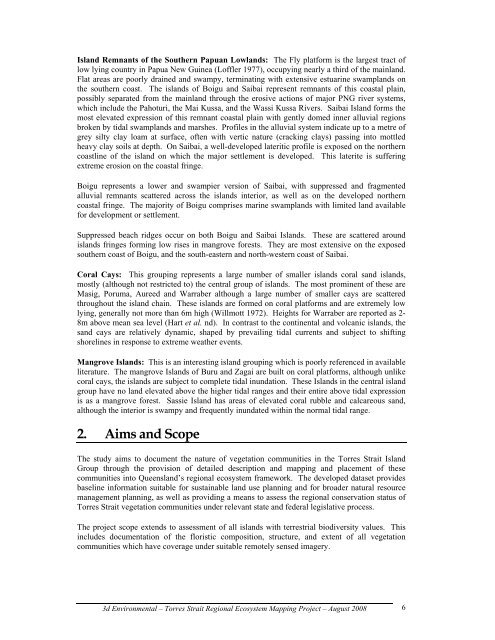Appendix 2 - Vegetation Communities and Regional Ecosystems
Appendix 2 - Vegetation Communities and Regional Ecosystems
Appendix 2 - Vegetation Communities and Regional Ecosystems
Create successful ePaper yourself
Turn your PDF publications into a flip-book with our unique Google optimized e-Paper software.
Isl<strong>and</strong> Remnants of the Southern Papuan Lowl<strong>and</strong>s: The Fly platform is the largest tract of<br />
low lying country in Papua New Guinea (Loffler 1977), occupying nearly a third of the mainl<strong>and</strong>.<br />
Flat areas are poorly drained <strong>and</strong> swampy, terminating with extensive estuarine swampl<strong>and</strong>s on<br />
the southern coast. The isl<strong>and</strong>s of Boigu <strong>and</strong> Saibai represent remnants of this coastal plain,<br />
possibly separated from the mainl<strong>and</strong> through the erosive actions of major PNG river systems,<br />
which include the Pahoturi, the Mai Kussa, <strong>and</strong> the Wassi Kussa Rivers. Saibai Isl<strong>and</strong> forms the<br />
most elevated expression of this remnant coastal plain with gently domed inner alluvial regions<br />
broken by tidal swampl<strong>and</strong>s <strong>and</strong> marshes. Profiles in the alluvial system indicate up to a metre of<br />
grey silty clay loam at surface, often with vertic nature (cracking clays) passing into mottled<br />
heavy clay soils at depth. On Saibai, a well-developed lateritic profile is exposed on the northern<br />
coastline of the isl<strong>and</strong> on which the major settlement is developed. This laterite is suffering<br />
extreme erosion on the coastal fringe.<br />
Boigu represents a lower <strong>and</strong> swampier version of Saibai, with suppressed <strong>and</strong> fragmented<br />
alluvial remnants scattered across the isl<strong>and</strong>s interior, as well as on the developed northern<br />
coastal fringe. The majority of Boigu comprises marine swampl<strong>and</strong>s with limited l<strong>and</strong> available<br />
for development or settlement.<br />
Suppressed beach ridges occur on both Boigu <strong>and</strong> Saibai Isl<strong>and</strong>s. These are scattered around<br />
isl<strong>and</strong>s fringes forming low rises in mangrove forests. They are most extensive on the exposed<br />
southern coast of Boigu, <strong>and</strong> the south-eastern <strong>and</strong> north-western coast of Saibai.<br />
Coral Cays: This grouping represents a large number of smaller isl<strong>and</strong>s coral s<strong>and</strong> isl<strong>and</strong>s,<br />
mostly (although not restricted to) the central group of isl<strong>and</strong>s. The most prominent of these are<br />
Masig, Poruma, Aureed <strong>and</strong> Warraber although a large number of smaller cays are scattered<br />
throughout the isl<strong>and</strong> chain. These isl<strong>and</strong>s are formed on coral platforms <strong>and</strong> are extremely low<br />
lying, generally not more than 6m high (Willmott 1972). Heights for Warraber are reported as 2-<br />
8m above mean sea level (Hart et al. nd). In contrast to the continental <strong>and</strong> volcanic isl<strong>and</strong>s, the<br />
s<strong>and</strong> cays are relatively dynamic, shaped by prevailing tidal currents <strong>and</strong> subject to shifting<br />
shorelines in response to extreme weather events.<br />
Mangrove Isl<strong>and</strong>s: This is an interesting isl<strong>and</strong> grouping which is poorly referenced in available<br />
literature. The mangrove Isl<strong>and</strong>s of Buru <strong>and</strong> Zagai are built on coral platforms, although unlike<br />
coral cays, the isl<strong>and</strong>s are subject to complete tidal inundation. These Isl<strong>and</strong>s in the central isl<strong>and</strong><br />
group have no l<strong>and</strong> elevated above the higher tidal ranges <strong>and</strong> their entire above tidal expression<br />
is as a mangrove forest. Sassie Isl<strong>and</strong> has areas of elevated coral rubble <strong>and</strong> calcareous s<strong>and</strong>,<br />
although the interior is swampy <strong>and</strong> frequently inundated within the normal tidal range.<br />
2. Aims <strong>and</strong> Scope<br />
The study aims to document the nature of vegetation communities in the Torres Strait Isl<strong>and</strong><br />
Group through the provision of detailed description <strong>and</strong> mapping <strong>and</strong> placement of these<br />
communities into Queensl<strong>and</strong>’s regional ecosystem framework. The developed dataset provides<br />
baseline information suitable for sustainable l<strong>and</strong> use planning <strong>and</strong> for broader natural resource<br />
management planning, as well as providing a means to assess the regional conservation status of<br />
Torres Strait vegetation communities under relevant state <strong>and</strong> federal legislative process.<br />
The project scope extends to assessment of all isl<strong>and</strong>s with terrestrial biodiversity values. This<br />
includes documentation of the floristic composition, structure, <strong>and</strong> extent of all vegetation<br />
communities which have coverage under suitable remotely sensed imagery.<br />
3d Environmental – Torres Strait <strong>Regional</strong> Ecosystem Mapping Project – August 2008<br />
6


